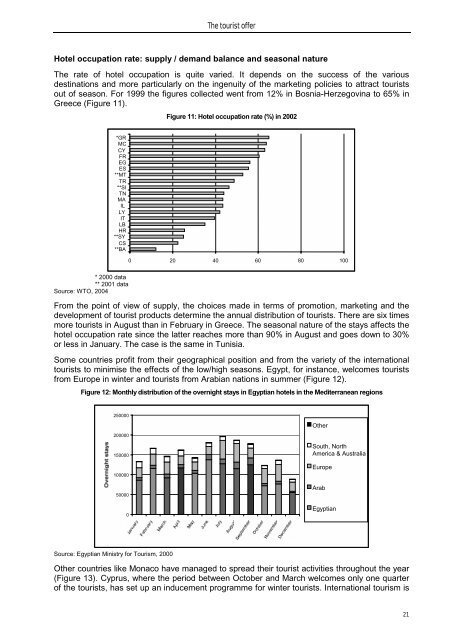dossier sur le tourisme et le développement durable
dossier sur le tourisme et le développement durable
dossier sur le tourisme et le développement durable
You also want an ePaper? Increase the reach of your titles
YUMPU automatically turns print PDFs into web optimized ePapers that Google loves.
The tourist offer<br />
Hotel occupation rate: supply / demand balance and seasonal nature<br />
The rate of hotel occupation is quite varied. It depends on the success of the various<br />
destinations and more particularly on the ingenuity of the mark<strong>et</strong>ing policies to attract tourists<br />
out of season. For 1999 the figures col<strong>le</strong>cted went from 12% in Bosnia-Herzegovina to 65% in<br />
Greece (Figure 11).<br />
*GR<br />
MC<br />
CY<br />
FR<br />
EG<br />
ES<br />
**MT<br />
TR<br />
**SI<br />
TN<br />
MA<br />
IL<br />
LY<br />
IT<br />
LB<br />
HR<br />
**SY<br />
CS<br />
**BA<br />
* 2000 data<br />
** 2001 data<br />
Source: WTO, 2004<br />
Figure 11: Hotel occupation rate (%) in 2002<br />
0 20 40 60 80 100<br />
From the point of view of supply, the choices made in terms of promotion, mark<strong>et</strong>ing and the<br />
development of tourist products d<strong>et</strong>ermine the annual distribution of tourists. There are six times<br />
more tourists in August than in February in Greece. The seasonal nature of the stays affects the<br />
hotel occupation rate since the latter reaches more than 90% in August and goes down to 30%<br />
or <strong>le</strong>ss in January. The case is the same in Tunisia.<br />
Some countries profit from their geographical position and from the vari<strong>et</strong>y of the international<br />
tourists to minimise the effects of the low/high seasons. Egypt, for instance, welcomes tourists<br />
from Europe in winter and tourists from Arabian nations in summer (Figure 12).<br />
Figure 12: Monthly distribution of the overnight stays in Egyptian hotels in the Mediterranean regions<br />
250000<br />
200000<br />
150000<br />
100000<br />
50000<br />
Source: Egyptian Ministry for Tourism, 2000<br />
0<br />
Other<br />
South, North<br />
America & Australia<br />
Europe<br />
Arab<br />
Egyptian<br />
Other countries like Monaco have managed to spread their tourist activities throughout the year<br />
(Figure 13). Cyprus, where the period b<strong>et</strong>ween October and March welcomes only one quarter<br />
of the tourists, has s<strong>et</strong> up an inducement programme for winter tourists. International tourism is<br />
21
















